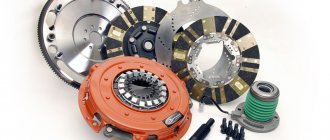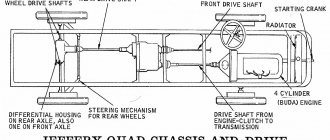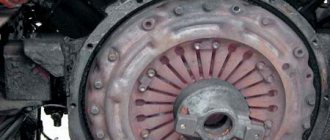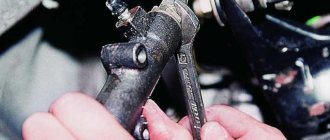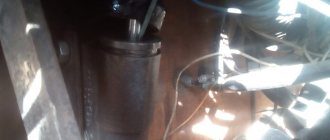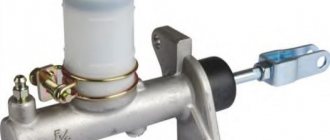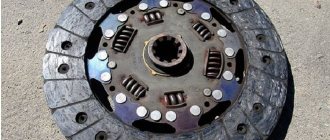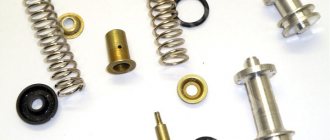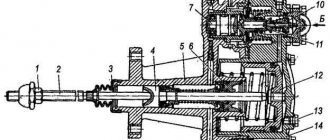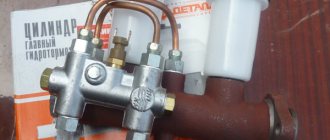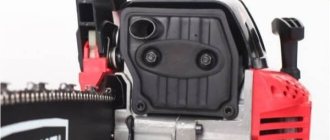Operating principle of the clutch slave cylinder
The hydraulic clutch slave cylinder receives the force imparted by the pedal to the master cylinder and, as a result of the pressure created in the pipeline, transmits it directly to the fork, which acts on the release bearing. It is an integral part of the system and is a cylindrical product attached to the clutch basket housing. A hydraulic drive tube enters it, and a rod comes out, resting on the cylinder piston on one side, and on the clutch fork on the other.
Operating principle and design
By pressing the pedal, there is an impact on the main cylinder, where pressure is created, as a result of which hydraulic fluid enters the working cylinder through the hose and discharge valve and, through the rod, actuates the pusher, which, by squeezing the fork, helps to engage or disengage the selected gear.
The design of the working cylinder shown in the photo is not as complicated as it might seem at first glance. It consists of the following main parts:
- respectively, the body itself, which can be plastic or iron;
- an air release valve located on it, which is used when pumping;
- return spring;
- working rod (piston);
- a pusher acting on the fork;
- retaining ring;
- rubber parts: o-rings and cuffs.
Clutch cylinder parts: 1 – housing;
2 – fitting; 3 – cap; 4 – pusher; 5 – sealing ring; 6 – piston; 7 – sealing ring; 8 – plate; 9 – spring; 10 – washer; 11 – retaining ring Wear or malfunction of some of the above parts can lead to deterioration of the entire clutch system, which can be judged by certain signs.
How to choose a clutch slave cylinder
When replacing the clutch slave cylinder, it is advisable to buy an original product made by the car manufacturer. If this is not possible, it is possible to install similar spare parts from a third-party manufacturer, but there is a high risk of purchasing a low-quality product. A part that has a price significantly lower than the original will quickly fail due to low-quality components and poor workmanship. This makes a cheap purchase economically unprofitable, since the need to purchase a quality product will remain.
Installation or replacement
Removing or replacing the clutch slave cylinder is carried out in the following order:
- Unscrewing the pair of bolts securing the cylinder body to the clutch housing.
- Disconnecting the pusher from the clutch fork.
- Disconnecting the hose connecting the clutch slave and master cylinders.
- Plug the hose with a suitable size plug to prevent liquid leakage.
Installing a new or repaired wheel cylinder is carried out in the reverse order, after which the system is pumped to fill it with brake fluid and remove air. During assembly, a special lubricant is applied to the pusher axis, usually CASMOLY L9508.
When is a GCS replacement necessary?
The clutch is a special part of the car that requires special attention. The overall condition of the engine depends on the quality of operation of the unit. In most cases, drivers can easily recognize problems that have arisen in their work.
Replacement of the main circulation system is necessary in the following cases:
- the piston mechanism works intermittently;
- cuffs allow brake fluid to pass through;
- presence of air in the hydraulic drive (this usually happens when the sealing rings are damaged).
Sometimes you will be able to detect problems with a visual inspection. For example, fluid leaks will be detected at the cylinder connection points or the pedal will fail when pressed.
Important! Detection of any system malfunction must be accompanied by appropriate measures. Driving with a faulty clutch is extremely dangerous!
It is better to immediately carry out the necessary diagnostics, since you may pay too high a price for ignoring it.
Clutch slave cylinder malfunctions
The following signs indicate an impending repair or replacement of the clutch slave cylinder:
- A sharp decrease in the fluid level in the reservoir with characteristic spots under the car in the area where the working brake cylinder is located. Signs indicate a fluid leak due to wear on the cuffs or damage to the integrity of the hose. Eliminated by replacing worn parts and restoring the tightness of the system.
- Dips or too soft clutch pedal travel. They indicate that air has entered the system, which is eliminated by bleeding. When examining the cylinder and finding cracks or leaks on the body through which air passes, the product is partially repaired or replaced.
- Gradual sagging of the clutch pedal and problems with gear shifting, while the fluid level in the reservoir does not drop, and adjusting the pedal does not bring any results. These are signs of a broken working cylinder spring; the problem can be eliminated by replacing it.
Role of the master cylinder
The proper operation of this unit has a direct impact on the operation of the gearbox (gearbox), its durability and smooth switching between speeds. The main function of the master cylinder is to timely disconnect the engine when the driver changes gears.
Important! The good condition of the clutch is characterized by smooth and silent operation of the mechanism.
The transmission gears disengage when changing gear, but you may hear minor grinding noises. Characteristic sounds indicate a malfunction of the mechanism. This grinding noise can occur if the clutch is not fully depressed.
GCS device
If malfunctions in the operation of the unit are detected, it is necessary to carry out repairs and, if necessary, replace the clutch master cylinder. Ignoring poor clutch performance may well lead to wear on the gear teeth and failure of the gearbox, and this will cost you much more. In addition, a malfunction of the box can occur while driving, which can lead to an accident.
The main parts of the mechanism include:
- tank;
- outer cuff;
- sealing collar;
- union;
- stock;
- return spring;
- frame;
- case for protection.
As you have already noticed, the design is quite simple. But this does not make it an eternal uninterrupted mechanism, because in some cases the GVC can cause serious troubles. In such cases, you cannot do without a thorough repair.
Repairing the clutch slave cylinder using a repair kit
Repairing the clutch slave cylinder begins with disassembling it. To do this, it is placed in a vice for convenience, after which the work is carried out in the following order:
- Removing the protective cap with the pusher, removing the piston and removing the retaining ring from it.
- Removing the sealing rings and spring from the piston.
- Cleaning all holes in the cylinder and the air outlet fitting.
- Inspection of the cylinder mirrors and the outer surface of the piston for mechanical damage.
- Flushing all parts and surfaces with brake fluid. The use of other solvents for this purpose is prohibited.
- Installation of parts of the repair kit, which includes a spring, a protective cap and piston o-rings.
- Cylinder assembly.
Bleeding the clutch slave cylinder
After installing the working cylinder in place, it is pumped as follows:
- Fill the master cylinder reservoir with brake fluid.
- A tube with the other end lowered into a container with brake fluid is connected to the air bleeder fitting of the working cylinder, which has been previously unscrewed ¾ of a turn.
- Repeatedly press the clutch pedal until air bubbles stop appearing from the tube, after which, with the pedal pressed all the way down, the fitting is screwed in.
- Disconnect the hoses and check the fluid level in the tank, which is topped up if necessary.
The described actions make it possible to eliminate the malfunction of the working cylinder of the clutch of all models of the VAZ: 2101, 2102, 2103, 2104, 2105, 2106, 2107, 2108, 2109, 21099, 2110, 2111, 2112, 2113, 2114, Niva, Priora, Starine, Grant, Grant. Vesta and most foreign cars.
Possible malfunctions and their causes
As such, there are no faults classified as serious and difficult to fix in the clutch master cylinder. Among the most common are the following:
- airiness of the system;
- leakage of working fluid;
- mechanical wear of cylinder elements.
Air ingress can become a serious problem, making normal operation of the hydraulic drive impossible. The reason for air getting inside the system is often microcracks in the connecting hoses or sealing cuffs itself. In order to eliminate the possibility of failure, the system requires bleeding. It can be performed independently, since no special skills or special tools are required. The procedure is quite standard, and most car owners are familiar with it firsthand.
Popular models and manufacturers
When choosing a non-original clutch slave cylinder, products from the following manufacturers are most often used:
- Sachs. The German company is a leading manufacturer of clutch cylinders for most automobile brands of foreign and domestic manufacturers. The popularity is due to the high quality of products and the use of innovative developments.
- Lukas. The largest manufacturer of auto parts, whose products meet all international quality standards. It produces brake cylinders for most automobile brands and repair kits for them.
- Fenox. Specializing in the production of clutch and brake cylinders for more than 25 years. Supplies products to most automakers.
- TRW. The company owns the Lukas brand and supplies brake system components, in particular brake cylinders, for all the world's largest automakers. The products are distinguished by their quality and extreme reliability.
- LUK. Official partner of major automakers in terms of designing new developments and systems. Supplies clutch cylinders to assembly lines of most of the world's major automakers.
Tips and tricks
Let's start with the fact that the working fluid in the clutch hydraulic drive is brake fluid (BF). The specified liquid is well suited to perform its assigned functions, is characterized by low price and availability, as well as ease of replacement.
It must be taken into account that such a liquid is a strong poison for living organisms and is aggressive towards plastic and rubber products, paintwork, etc. It is not difficult to guess that rubber seals quickly become unusable from contact with brake fluid (drying out and cracking occurs).
Brake fluid also tends to accumulate moisture over time (it is hygroscopic). This leads to both deterioration of its properties and the development of corrosion of parts with which it comes into contact.
The fact is that TJs are not resistant to electricity. In practice, even low voltage leads to precipitation and active crystallization of the constituent elements of the liquid occurs.
Please note that if the GCS is made of metal (for example, has a cast iron body), and the piston-cylinder is made of aluminum, a small electrical potential is created as a result of contact with the brake fluid.
This leads to the formation of sediment. To avoid crystallization of the fuel fluid, you need to choose a replacement GCS with a piston made of polymers. This piston is distinguished by the fact that it does not interact with the metal of the housing and has less impact on the cylinder bore. You can also pay attention to the brass piston, however, the cost of the part is very high compared to analogues.
For this reason, it is optimal to change the brake fluid once a year or every 20-25 thousand km. mileage This approach allows you to extend the service life of brake and clutch cylinders.
Finally, we note that you need to add brake fluid so that dust, dirt and debris do not get into the reservoir. Otherwise, small particles can act like an abrasive, quickly damaging the smooth and sensitive internal surfaces of brake and clutch components.
Squeezing the clutch before starting the engine: when you need to squeeze the clutch and in what cases it is not recommended to do so. Useful tips and tricks.
How to change gears without a clutch: driving a manual car without a clutch in case of malfunction. Tips and tricks.
Car clutch: purpose, types, design, principle of operation. Frequent clutch malfunctions in the vehicle transmission system, signs of problems.
Why the speed drops and the engine stalls when the clutch is depressed: possible causes of the malfunction. Diagnosis of the problem, checking, replacing individual elements.
How is the clutch implemented in the transmission device on cars with automatic transmission compared to a manual or robotic transmission. Features and differences.
How to use the DSG gearbox and save resource, as well as increase service life. Features of operating a robotic gearbox with two clutches.
Source
